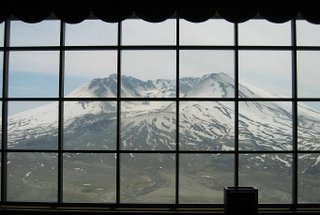The mountain that once was - Mount St. Helens
 Riffe Lake - on way to St. Helens
Riffe Lake - on way to St. Helens
Sunit and I were both excited. We had first heard about St. Helens in October 2004 when it was all over the news - apparently the mountain was spewing up gas and debri again after a span of almost 25 years. People from all over the country were travelling to see if St. Helens would erupt again. The last time it had erupted in 1980, the whole north side of the mountain had disintegrated and flown down, burning the surrounding forests, killing about 1.5 million animals and 57 people in an already evacuated area.
We were glad we had planned to visit the mountain on the day the Johnston Ridge Observatory (closest to the mountain) was due to open for the season. The Observatory is but 5.5 miles from the mountain.
We drove on towards the mountain. At the lower reaches, we could see forests with fairly young trees and occasional signboards indicating when they were planted after the 1980 eruption. At the higher reaches though, as we got closer to the top of the mountain, there was not much in terms of vegetation. At a distance, we could still see the path of the lava flow during the 1980 eruption.
Johnston Ridge Observatory provided some spectacular views of the mountain at close quarters. There were also lots of Ranger and other educational sessions educating the visitors about the history and the state of the current eruption. Did I mention, the mountain is still throwing up smoke and rock at the rate of 1 sq. yard/second and if it continues to throw up at this rate, it would regain its original height before the 1980 eruption in another 100 years.
 Loowit - Lady of Fire - still smoking
Loowit - Lady of Fire - still smoking
At the observatory, we saw a theatre presentation on the history of the 1980 eruption. The Obervatory apparently is named after "David Johnston", a volcanologist, who was on duty and was killed during the eruption. His last words relayed to the USGS base in Vancouver were "Vancouver! Vancouver! This is it!". Shivers ran down my spine as they showed the eruption through his camera, how the eruption reached him within seconds and I thought about the last moments of this man. The finale of the presentation was a curtain raiser with a spectacular view of the mountain.
On our way back, we also visited the Coldwater Observatory - another observatory for St. Helens. This is where Johnston was during the 1980 eruption and was overtaken by the avalanche of debri flow. Today there is a beautiful lake here and marine life is beginning to come back. Nature sure has a way of mending itself.
 Coldwater Lake
Coldwater Lake


Comments
You really plan your trips very meticulously and cover all the places worth visiting. I have ended up suggesting a visit to ur blog to a couple of my friends who are going to places you have been to :-) For me reading ur blog has become almost like a weekly activity.
As usual, ur Seattle snaps are wow !
Take care
Thanks for visiting and the very nice words :-)
Hope you and the little one are doing well.
Take care